Japanese units of measurement
Frederic P. Miller, Agnes F. Vandome, John McBrewster
бумажная книга
High Quality Content by WIKIPEDIA articles! Shakkan-h? is the traditional Japanese system of measurement. The name shakkanh? originates from the name of two of the units, the shaku, a unit of length, and the kan, a mass measurement. The system is Chinese in origin. The units originated in the Shang Dynasty in the 13th century BC, and eventually stabilized in the Zhou Dynasty in the 10th century BC and spread from there to Japan, South East Asia, and Korea. The units of the Tang Dynasty were officially adopted in Japan in 701, and the current shaku measurement has hardly altered since then. Many Taiwanese units of measurement are derived form the shakkanh? system.From 1924, the shakkanh? system was replaced by the metric system, and use of the old units for official purposes was forbidden after 31 March 1966. However, in several instances the old system is still used. In carpentry and agriculture use of the old fashioned terms is common. Tools such as Japanese chisels, spatels, saws, hammers are manufactured in sizes of sun and bu. Land is sold on the basis of price in tsubo. The 2005 Japanese census allowed people to give the area of their houses in either square metres or tsubo.
Данное издание не является оригинальным. Книга печатается по технологии принт-он-деманд после получения заказа.


